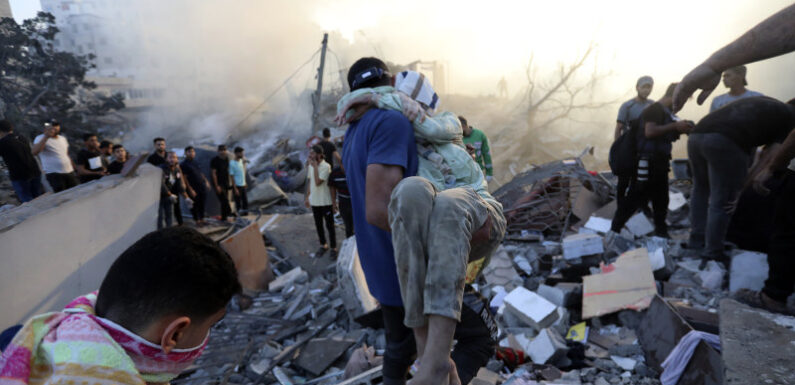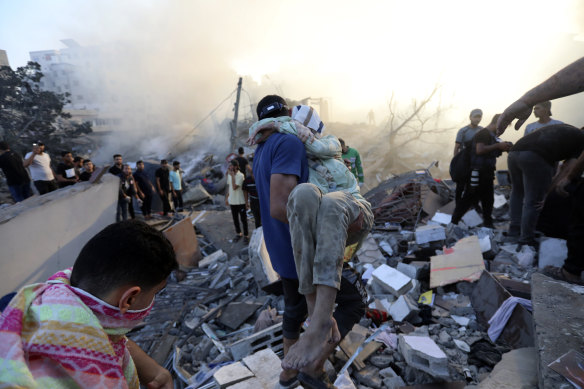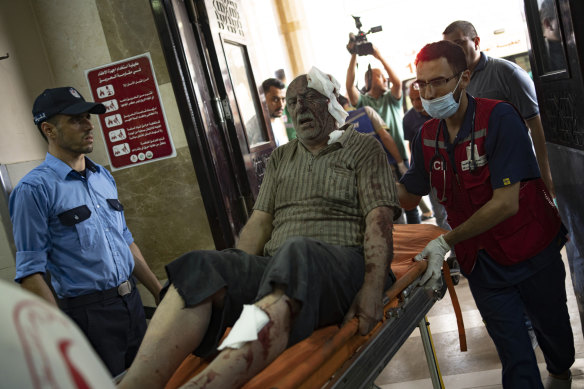
Save articles for later
Add articles to your saved list and come back to them any time.
Key points
- US officials: Invading Gaza could spur Iran-backed attacks on US forces.
- Netanyahu reaffirms Israel preparing for Gaza invasion.
- Israel bombs south Gaza after warning Palestinians to leave north.
- France’s Macron says Gaza invasion would be ‘error’ for Israel.
Gaza/Jerusalem: Israel stepped up bombings of south Gaza, killing many Palestinians, officials said on Wednesday, as violence flared elsewhere in the Middle East and a showdown loomed at the United Nations over aid for the besieged enclave.
Hundreds of thousands of Palestinians fled from north to south in tiny, crowded Gaza after Israel warned them it would bombard mainly the north to wipe out Hamas militants after their cross-border killing and kidnapping spree in Israel on October 7.
A Palestinian man evacuates a wounded girl out of the destruction following Israeli airstrikes on Gaza City.Credit: AP
Among Wednesday’s casualties, an internally displaced person was killed and 44 were injured in an air strike near an UNRWA school in the southern town of Rafah, the UN agency for Palestinian refugees in the Gaza Strip said.
The school was sheltering 4600 people and sustained severe collateral damage, an UNRWA statement said.
The overall Palestinian death toll now exceeds 6500, the health ministry in Hamas-ruled Gaza said on Wednesday. Reuters has not been able to independently verify the casualty figures of either side in the war.
Israel had told civilians in the northern Gaza Strip, including residents of Gaza City, to move to the south of the enclave, saying it will be safer there as the military attacks Hamas following its October 7 cross-border assault.
A wounded Palestinian man is wheeled into the Nasser Medical Complex, following Israeli airstrikes on the town of Khan Younis southern Gaza Strip.Credit: AP
However, Israeli warplanes have continued to hit sites in southern Gaza, spreading fear among the evacuees that they are just as vulnerable there as they were in their homes in the north.
Israeli tanks and troops are massed on the border with Gaza awaiting orders for an expected ground invasion amid growing international pressure on Israel to exercise restraint to avoid endangering more than 200 Israeli hostages in Gaza and enable aid to reach stricken Palestinian civilians in the enclave.
The Wall Street Journal, citing US and Israeli officials, reported later on Wednesday Israel had agreed to delay invading Gaza for now so that the United States could rush missile defences to the region to protect its forces there – reflecting its concern about the Gaza war spreading around the Middle East.
US officials have so far persuaded Israel to hold off until US air defence systems can be placed in the region, as early as this week, the WSJ said.
Asked about the report, US officials told Reuters that Washington has raised its concerns with Israel that Iran and Iranian-backed Islamist groups could escalate the conflict by attacking US troops in the Middle East. An Israeli incursion into Gaza could be a trigger for Iranian proxies, they said.
Later on Wednesday, Prime Minister Benjamin Netanyahu reaffirmed that Israel was preparing an offensive into Gaza.
“We have already killed thousands of terrorists and this is only the beginning,” Netanyahu said in a televised statement.
“Simultaneously, we are preparing for a ground invasion. I will not elaborate on when, how or how many.”
The WSJ said Israel’s position was taking into account international efforts to get emergency aid unimpeded into Gaza as well as sensitive mediation by Gulf Arab state Qatar to free Israelis in Hamas captivity.
Israeli officials have increasingly signalled in public that a Gaza invasion could be imminent. None has given a hard date, however, or said there has been a postponement. Israel has called up a record 300,000 military reservists.
The Israeli-Hamas war has already kindled increased conflict well beyond Gaza.
Israeli warplanes struck Syrian army infrastructure in response to rockets fired from Syria, an ally of Iran.
Syrian state media said Israel had killed eight soldiers and wounded seven near the southwestern city of Deraa, and hit Aleppo airport in the northwest, already out of action.
Israel did not accuse the Syrian army of launching rockets but is suspicious of Iran, its arch-enemy which has a significant military and security presence in Syria.
Iran has sought regional ascendancy for decades and backs armed groups in Syria, Lebanon and elsewhere as well as Hamas. It has warned Israel to stop its onslaught on Gaza.
Israel said its forces also hit five squads in south Lebanon preparing attacks. Lebanon’s Iranian-backed Hezbollah group said 42 of its fighters had been killed since border clashes with Israel resumed after the Gaza war erupted.
Israeli-Hezbollah clashes have unnerved civilians on both sides of the border.
US and Russia at odds over aid calls
The United States and Russia are leading rival calls at the United Nations for a pause in fighting to allow aid into Gaza, where living conditions are harrowing with medical care crippled due to a lack of electricity, and food and clean water scarce.
Limited deliveries of food, medicine and water from Egypt restarted on Saturday through Rafah, the only crossing not controlled by Israel, which announced it had sealed off the coastal enclave for good after this month’s attack from Hamas.
UN agencies say more than 20 times as much is needed by the Gaza Strip’s 2.3 million people, even in peacetime.
In proposals the UN Security Council was expected to consider on Wednesday, the United States was seeking short pauses to allow aid in while Russia advocates a wider ceasefire. Israel has resisted both, arguing that Hamas would only take advantage and create new threats to its civilians.
Palestinian sense of betrayal
Israel started its aerial blitz against Gaza after Hamas militants stormed southern Israeli towns in a shock infiltration on October 7, killing 1400 people, most of them civilians, and taking some 222 people hostage.
Gaza’s health ministry said at least 6546 Palestinians had been killed by Israeli bombardments since then, including 2704 children. Of the total, 756 had been killed in the previous 24 hours, half of them children, it said – even more than the 704 it reported on Tuesday.
Palestinian anger over civilian deaths have been inflamed further by a sense of betrayal as many of those who heeded Israel’s call to move south are also being killed. The Israeli military says that Hamas, which seized control in Gaza in 2007, has entrenched itself among the civilian population everywhere.
One overnight strike brought down several apartment buildings in the southern Gaza town of Khan Younis.
“This is something not normal, we have not heard something like this before,” said Khader Abu Odah, one of many shell-shocked residents waiting for an excavator to lift rubble so they could look for survivors.
Israel said its latest strikes had eliminated more Hamas operatives and including the head of the Islamist group’s battalion for Khan Younis, Tayseer Bebasher.
Reuters
More coverage of the Hamas-Israel conflict
- Cascading violence: Tremors from the Hamas attacks and Israel’s response have reached far beyond the border. But what would all-out war in the Middle East look like?
- The human cost: Hamas’ massacre in Israel has traumatised – and hardened – survivors. And in Gaza, neighbourhoods have become ghost cities.
- “Hamas metro”: Inside the labyrinthine network of underground tunnels, which the Palestinian militant group has commanded beneath war-ravaged Gaza for 16 years. The covert corridors have long provided essential channels for the movement of weapons and armed combatants.
- What is Hezbollah?: As fears of the conflict expanding beyond Israel and Hamas steadily rise, all eyes are on the militant group and political party that controls southern Lebanon and has been designated internationally as a terrorist group. How did it form and what does Iran have to do with it?
Most Viewed in World
From our partners
Source: Read Full Article

